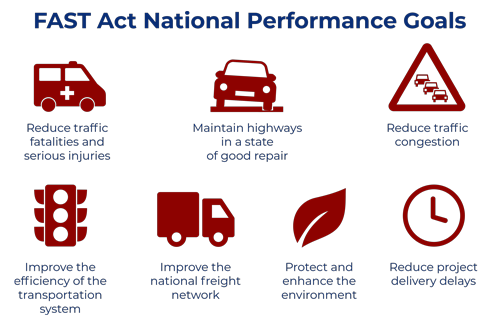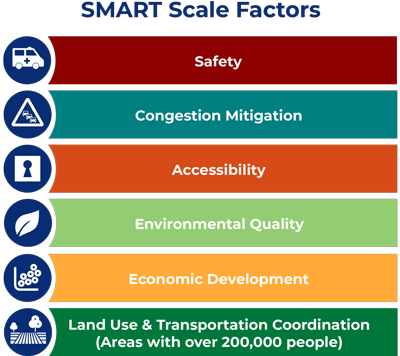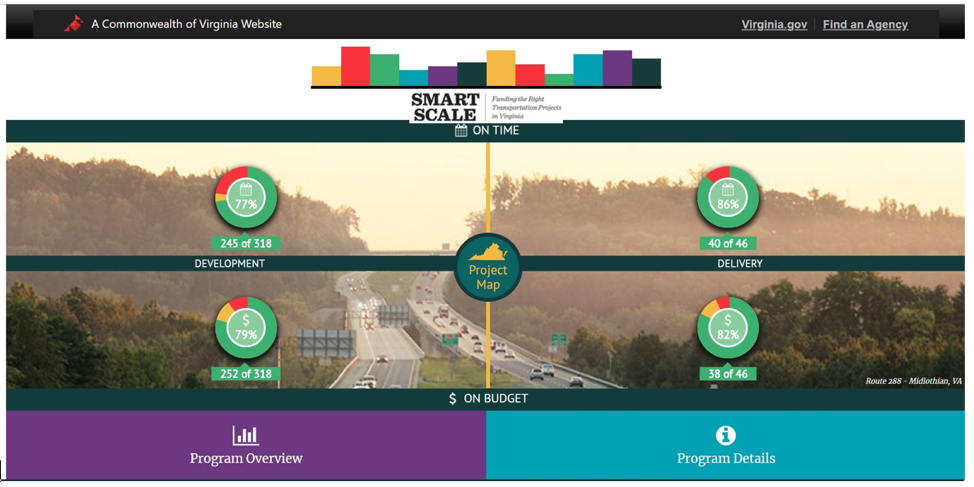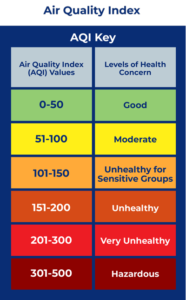all about transportation
Federal & State Requirements
Long-range transportation planning is guided by federal regulations and statutes. These include factors of the planning process and basic components the plan should consider. Current transportation authorizing legislation and statewide planning processes incorporate performance goals, measures and targets in the process of identifying needed transportation improvements and projects.
Federal Requirements
Federal Aid Highway Act
In 1962, Congress established requirements that transportation planning in the United States be conducted in a “comprehensive, continuous, and coordinated” manner (the 3-C Process). The Federal Aid Highway Act of 1973 mandated the creation of Metropolitan Planning Organizations (MPOs) in each urbanized area with a population of 50,000 or more.
MAP-21
The Moving Ahead for Progress in the 21st Century Act (MAP-21), enacted in 2012, included provisions to make federal surface transportation more streamlined, performance-based and multimodal, and to address challenges facing the U.S. transportation system, including improving safety, maintaining infrastructure condition, reducing traffic congestion, improving efficiency of the system and freight movement, protecting the environment, and reducing delays in project delivery.
FAST Act (Current Authorization)
In 2015, the Fixing America’s Surface Transportation Act (FAST Act) was passed. The FAST Act funds surface transportation programs and is the first long-term surface transportation authorization enacted in a decade that provides long-term funding certainty for surface transportation.
Setting the course for transportation investment in highways, the FAST Act:
- Improves mobility on America’s highways
- Establishes and funds new programs to support critical transportation projects to ease congestion and facilitate the movement of freight on the Interstate System and other major roads
- Creates jobs and supports economic growth
- Authorizes funding for road, bridge, bicycling and walking improvements
- Includes a number of provisions designed to improve freight movement
- Accelerates project delivery and promotes innovation

Air Quality
The Richmond-Petersburg Area was previously designated a nonattainment area under the 1997 ozone standard and later a maintenance area before being designated an attainment area under the 2008 ozone standard. The area is currently in attainment for all standards including the 2015 ozone standard.
In February 2018, the D.C. Circuit Court issued a decision in South Coast Air Quality Management District v. EPA which impacted areas like the Richmond-Petersburg Area that had been designated nonattainment and/or maintenance under the 1997 ozone standard but designated attainment under the 2008 ozone standard. One of those impacts is that new, updated, or amended Transportation Improvement Program and Long-Range Transportation Plan must demonstrate conformity in keeping with the anti-backsliding requirements associated with the revocation of the 1997 ozone standard.
On September 25, 2018, FHWA transmitted a copy of the final report of the Transportation Conformity Analysis prepared for the for the FY 2018-2021 Transportation Improvement Programs and 2040 Long-Range Transportation Plan prepared by the RRTPO for the 1997 ozone standard. The conformity analysis was prepared in accordance with EPA's November 24, 1993, Final Rule on Criteria and Procedures for Determining Conformity and subsequent rulemakings related to ozone. EPA has completed their formal review and by letter dated October 16, 2018, they informed FHWA and FTA that they concur that the conformity analysis demonstrates that the TIP and CLRP prepared for the Richmond-Petersburg 1997 Ozone Area meet the requirements of the CAA and applicable regulations.
State Requirements
Virginia’s goal is to ensure that the transportation system is safe, enables the movement of people and goods, enhances the economy, and improves quality of life. Virginia’s SMART SCALE program (§33.2-214.1) provides a method of choosing the right transportation projects for funding to ensure the best use of limited tax dollars. The program has a standardized, data-driven method of scoring and prioritizing planned projects. Transportation projects are scored based on an objective, outcome-based process that is transparent to the public and allows decision-makers to be held accountable to taxpayers. Once projects are scored and prioritized, the Commonwealth Transportation Board (CTB) has the best information possible to select the right projects for funding.
On February 21, 2018, the CTB passed a resolution adopting a corrected policy and approving the guide for implementation of the SMART SCALE Project Prioritization Process. SMART SCALE requires that projects be evaluated for Safety, Congestion Mitigation, Accessibility, Environmental Quality, Economic Development and, in areas with more than 200,000 people, Land Use and Transportation Coordination.


Virginia has transportation indicators to help assess progress, understand key elements that impact performance, and ensure that the transportation system is safe and efficient.
The SMART SCALE process is conducted every two years, and Round 3 of SMART SCALE began in March 2018. Once funded, our performance in executing these projects is tracked through the SMART SCALE Dashboard. Candidate projects, applications and rankings can be found on the SMART SCALE Portal.
Learn more:



